Roadways are Dangerous
Understanding The Unique Nature of Roadway Claims
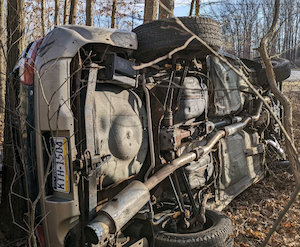
We handle all kinds of injury claims: from slip-and-fall accidents on dangerous walkways to injuries in motor vehicles. We gather evidence, take pictures of vehicle damage, and place the responsible parties on notice of the claims for prompt resolution.
But note: the law treats roadway injury claims much differently than other claims, which is the focus of this page.
A Non-Motor Vehicle Example, For Comparison
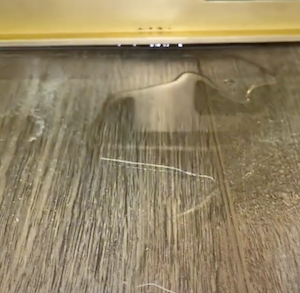 So let’s say you’re walking in the mall and slip on a patch of spilled liquid detergent, left by a mall employee by accident. As a result, you fall and sprain your ankle — not seriously — but you go to the hospital and follow a prescribed regimen for 6 physical therapy visits. Afterward, you’re good as new, but as an Amazon delivery person, you missed work from the fall.
So let’s say you’re walking in the mall and slip on a patch of spilled liquid detergent, left by a mall employee by accident. As a result, you fall and sprain your ankle — not seriously — but you go to the hospital and follow a prescribed regimen for 6 physical therapy visits. Afterward, you’re good as new, but as an Amazon delivery person, you missed work from the fall.
So you hire a lawyer, who puts the mall on notice of your claims for damages for the mall’s employee’s negligence. The mall and its employee both admit fault. Great!
What items can be claimed?
Your lawyers submits in support of your claim:
-
- Proof of your medical bills (not the amount claimed by the hospital, but the amount it expected to actually receive) – $10,000
- A claim for your lost wages for the time missed from work, $5,000, and
- A claim for pain and suffering, estimated at $20,000, but there’s no objective metric.
The mall — or its liability insurance carrier — reviews the claim and settles all your claims for a total of $25,000, which pays all of your medical bills, lost wage, and your attorney fees, leaving you with several thousand dollars in your pocket.
Parenthetically, if your private health insurance paid your medical bills, you may need to pay said insurance company back, out of your settlement, but your lawyer compromises down the payback, meaning, he “satisfies the subrogation lien,” so you still walk away with several thousand dollars in your pocket.
Simple, right? Only, what if the same mall employee injures you with his car; this time, on a roadway?
A much different result, possibly.
The Roadway Example, by Contrast
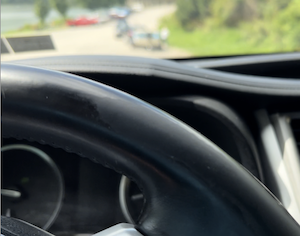 Let’s go with the same geographic setting as above: the mall, except this time, you’re driving on the street in front of the mall, and the mall employee rear-ends your vehicle, while running an errand for the mall. You sustain the identical injury as before, but this time, you slide forward and sprain your ankle against the brake pedal, creating the exact same ankle strain injury.
Let’s go with the same geographic setting as above: the mall, except this time, you’re driving on the street in front of the mall, and the mall employee rear-ends your vehicle, while running an errand for the mall. You sustain the identical injury as before, but this time, you slide forward and sprain your ankle against the brake pedal, creating the exact same ankle strain injury.
You go to the same hospital. And you get the same diagnosis, same treatment, and the same medical bills.
You also lose the exact same amount of wages from the accident.
And, once again, both the mall and its employee admit liability.
But this time, the mall and/or its liability insurance carrier deny your claim, and say, good luck in court.
But why?
Unique Aspects of Motor Vehicle Law in PA
Pennsylvania’s Motor Vehicle Financial Responsibility Law (“MVFRL”) exists via a statute (Title 75) that carves out numerous exceptions — and limitations — to claims for injuries from vehicle accidents. Some of the key aspects are described below.
No-Fault Medical Coverage
If you have motor vehicle insurance in PA, every policy has at least $5,000 of medical coverage — for the party covered under the policy — to pay your medical bills when you’re injured in a motor vehicle accident. This coverage is “no-fault,” meaning, it pays your medical bills (related to a vehicle accident), regardless of who caused the accident.
Sounds good right?
Only, in the mall scenario, where your vehicle is rear-ended, the mall employee (or his insurance carrier) will deny your claim for payment of medical bills, unless you first present those for payment to your own auto insurance carrier.
Motor Vehicle Lost Wage Coverage
Let’s stay on the subject of your own auto insurance.
Let’s say you also carry lost wage coverage — though not required — through your own auto carrier to pay for your own lost time from work from an accident. If you carry such coverage, once again, you must turn to your own insurance carrier first, to pay your lost wage claim. You must also exhaust said coverage, just like no-fault medical coverage, before you can make any claim on the other driver for lost wages or lost earning capacity.
Good New and Bad News
There are two more ways in which your motor vehicle claims will differ from another type of injury claim, such as a slip and fall.
Often the “Bad News”: Limited Tort Coverage
The concept of “limited tort” limits your ability to sue for pain and suffering from an accident. In the above scenario, your lawyer asserted a claim for $10,000. But the law deems you bound by “limited tort,” so you can claim nothing for “pain and suffering” for the auto accident, unlike the fall in the mall.
But why?
Those selling automobile insurance coverage give you the option to elect “full tort” or “limited tort” on your policy. Full tort costs more: about $100 per year. But it preserves your right to sue for pain and suffering. Limited tort — though a little less expensive — limits your ability to sue for pain and suffering, also known as non-economic damages. Even if bound by “limited tort,” you can sue for economic harm — such as lost wages or vehicle repair costs, but not pain and suffering, unless an exception to limited tot exists. These include:
-
- Drunk Driving Conviction. The other driver was convicted (or pleaded “no contest”) to a drunk driving charge for the accident or had a vehicle registered out of state, or, more commonly.
- Vehicle Registered Out-Of-State. The negligent driver’s vehicle is registered out of PA.
- Serious Injury. Your injuries amount to a substantial limitation of your lifestyle from an injury to an important bodily function, requiring surgery, or some other significant treatment that limits you substantially. Or,
- Permanent Impairment. You suffered permanent and significant disfigurement from the accident.
But when you were rear-ended — driving in front of the mall — your injuries were non-serious. No surgery was needed, for example. There was no substantial impairment to your life, other than you hobbling around for a few weeks. So if bound by limited tort, you could only claim your lost wages of $5,000. But then, your lawyer — who only dabbles in motor vehicle law — messes up. He fails to first present the claim for lost wages to your own automobile insurance carrier, since you have lost wage coverage on your policy, described above.
So the offer is zero.
The Good News – UM / UIM Coverage
Let’s say the mall is in dire straits, financially. It carries substantially more debt than assets and you find out the hard way: when making a claim. For the mall, money is so tight, it has failed to pay for liability insurance, so when you fall at the mall, and sustain the injuries described above, there’s no money available to compensate you. And therefore no lawyer — working on a contingency basis — will take your case. Sounds pretty bleak, because it is. You go into debt from the fall, and you consider bankruptcy, yourself!
But in the motor vehicle scenario, there’s a ray of hope.
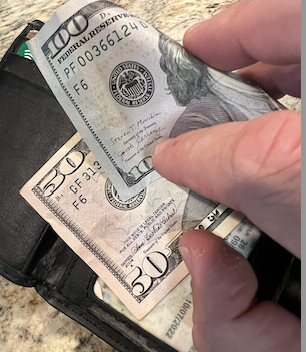 Motor vehicle insurance companies in PA present you the option of electing something called underinsured motorist coverage (“UIM”) or uninsured motorist coverage (“UM”). This coverage, if you elect it and pay for it, compensates you for pain and suffering and other items of damages even if the negligent party lacks any coverage at all.
Motor vehicle insurance companies in PA present you the option of electing something called underinsured motorist coverage (“UIM”) or uninsured motorist coverage (“UM”). This coverage, if you elect it and pay for it, compensates you for pain and suffering and other items of damages even if the negligent party lacks any coverage at all.
Your auto carrier effectively steps in the shoes of the negligent driver, to make payment.
Uninsured Motorist Coverage (“UM”). So let’s say the mall employee had been driving without automobile liability insurance coverage, but you carry 50K in uninsured motorist coverage. Your own insurer would pay the full value of your claim: approximately $25,000.
Underinsured Motorist Coverage (UIM). Let’s say the negligent mall employee only has the state minimum $15,000 in coverage, with your UIM, your underinsured motorist coverage would bridge the difference to $25,000 and pay you $10,000. And, if not tendered, your own auto carrier owes you special duties of good faith. Otherwise, you can sue your own auto carrier for “bad faith,” for either a significant delay in settling or for failing to evaluate the claim fairly.
Selecting the Right Legal Representative
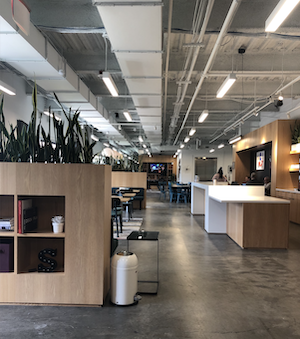 We got through it!
We got through it!
Bottom line: motor vehicle injury claims are complicated. And we haven’t even discussed medicare liens, or laws that apply to accident claims, when the drivers live in different states!
Call or email us today for a free consultation to learn your rights to claim damages from roadway injuries.
Let’s Get Started!
412.342.0992
